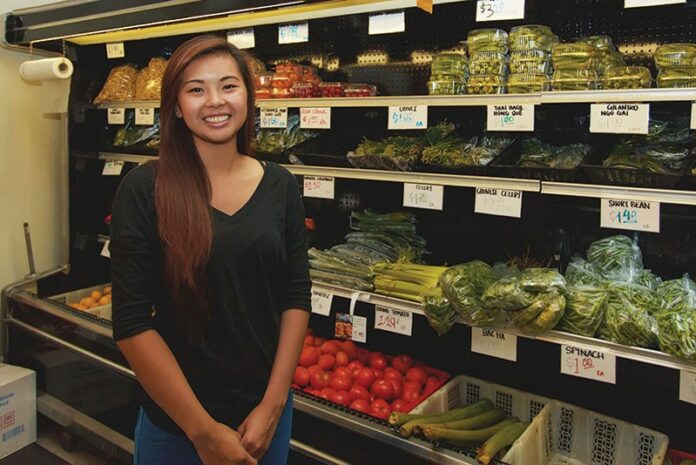Step off Sebastopol Road into Mekong Market, and the first thing you see is a crate of fresh-cut herbs beside a fruit stand filled with mangos, plantains, piles of exotic lychees and other fruits.
This is a big change for the 25- year-old family-run grocery. Three years ago, the front counter area at the Roseland market was stuffed with chips, candy and cans of Spam.
Small grocers rely on those high-margin items (along with alcohol and cigarette sales), but a multi-year initiative designating the Roseland neighborhood in unincorporated Sonoma County west of Santa Rosa as a “HEAL Zone” (Healthy Eating, Active Living) has encouraged stores like Mekong to provide healthier, highly visible options.
Yen Truong, whose parents own the store, says customers’ buying patterns have shifted. “Now we actually have a lot more sales of the fruits. People go for those instead of the chips.”
Truong credits the Healthy Food Outlet Project, one of many community programs under the HEAL Zone umbrella, for the help it gave Mekong when it applied for redevelopment money in 2011 before redevelopment agencies were shut down. The money helped the Truongs improve lighting and signage. Inside, they’ve switched out unhealthy marketing for postcards promoting veggies and fruit.
Mekong is squarely located in a low-income neighborhood that has an average yearly income of $22,000, according to county figures. East Bennett Valley, just a few miles away, has averages of $69,000.
More than one in three low-income children and almost half of low-income teens in Sonoma County are overweight or obese, according to 2007–09 data from the U.S. Centers for Disease Control. Obesity increases the risk of developing diabetes, hypertension and heart disease in later life.
Studies show that low-income communities correlate with some of the state’s highest obesity rates. For that reason, community groups and county agencies targeted Roseland and southwest Santa Rosa for a HEAL Community Health Initiative in 2006.
The goal, according to the initiative, is to promote better health in low-income areas through “sustainable policy, systems and environmental change across schools, worksites, healthcare facilities, and neighborhoods.”
“This is how we create norm change,” says Laurie Hiatt, a consultant with the Healthy Food Outlet Project.
Hiatt consults with markets on how to pare down advertising for unhealthful foods and habits, while promoting and selling fresh, affordable produce. The stores sign on for the promotion and, it’s hoped, to help improve the health of the community.
Hiatt rates each market’s stock of fruits and vegetables, i.e., what kind of advertising is featured and its proximity to consumers. The business is scored on a scale from one to 100; low-performing stores get a kit to help raise their score above 75.
“The store owners get competitive,” says Hiatt, who works with seven Roseland stores, three of which have met the healthy-food-outlet standard: Mekong, Tarasco’s and Lola’s Market.
On a recent weekday morning, Tarasco’s owner, Sylvia Camacho, shared anecdotes about her customers’ changing habits. That day, she says, a man came in to buy a drink, compared the nutrition labels on two beverages, and chose the one with less sugar.
“Another customer came in with her daughter,” recalls Camacho, who bought Tarasco’s nine years ago. “The daughter wanted chips, but her mom said no. At the front counter, we have sweet nectarines and peaches, and the lady told her daughter to eat the fruit instead. They bought one, washed it in the back of the store, and the girl ate it right there.”
The produce section at Tarasco’s is impressive but takes a bit of navigating to find: tucked away and out of sight of the front door is an area flush with well-maintained mounds of avocados, nopales, dried chiles, apples and greens.
Liliana Vazquez, 33, shops for her family at Tarasco’s at least twice a week. The Roseland resident has been a customer since long before Camacho bought the store, and says she’s noticed the changes.
“There are more choices in vegetables and fruit,” says Vazquez, who like many people in the neighborhood, shops exclusively at this small corner market. It’s a shift Vazquez appreciates, especially since she’s noted others around her buying more vegetables too.
This article was produced as a project for the California Endowment Health Journalism Fellowships, a program of USC’s Annenberg School of Journalism.











